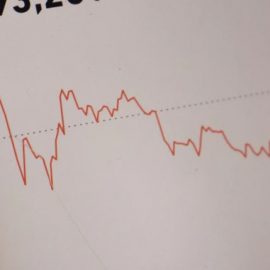

This article is an excerpt from the Shortform book guide to "Beating the Street" by Peter Lynch. Shortform has the world's best summaries and analyses of books you should be reading.
Like this article? Sign up for a free trial here.
What are the risks of bonds? Do they carry more or less risk than stocks?
Many investors think that bonds are less risky than stocks. However, in his book Beating the Street, famed mutual fund manager Peter Lynch explains that bonds offer poorer returns than stocks over the long haul.
Read more to understand the basics of how bonds work and two of the primary risks that come with investing in them.
How Bonds Work
What are the risks of bonds? To answer that question, we need to start with what bonds are and how they work. A bond is a debt obligation issued by a borrower—with the borrower usually being a corporation, a state or municipal government, or the US Treasury. These entities issue bonds to raise capital. When you purchase a bond as an investor, you’re loaning money to the bond issuer, which pays you back with interest.
We can illustrate how bonds work with an example. When you buy a $1,000 bond from the issuer, it typically pays out interest at a fixed rate (the coupon rate) for a specified period of time. At the end of this period, the bond purchaser receives the full $1,000 value of the bond (the face value). So if your one-year $1,000 bond pays out 5% interest, you’ll receive a 5% ($50) interest payment after six months (the coupon date). After one year, the bond will reach its maturity date, when the face value of the bond comes due and you’ll be paid back the $1,000 face value. So, over the course of your investment, you’ll have earned a 5% return on $1,000.
(Shortform note: This simple illustration of bonds doesn’t fully outline some of the other options that bond issuers may exercise—and that can put your returns at risk. In The Simple Path to Wealth, JL Collins writes that some bonds are “callable.” This means that the bond issuer may have the option to “call back” the bonds or pay them off before the maturity date. Bond issuers typically do this when interest rates are falling and they can borrow more cheaply by issuing new, lower-rate bonds, the proceeds from which they can use to pay off old, high-interest bonds. Thus, if your bond is called back, you’ll receive your face value payment earlier, but you’ll lose out on those high fixed-interest payments.)
The Risks of Bonds
This simple illustration of bonds makes them seem like an attractive, low-risk, low-stress investment. But, warns Lynch, bonds are actually fraught with risk because their real returns are highly vulnerable to 1) inflation, and 2) interest rate changes.
(Shortform note: Contrary to Lynch’s argument, some experts write that there are market conditions where bonds can be a better investment than stocks. For example, in 2023, analysts argued that a weak stock market and the unsustainability of corporate profits made bonds a safer—and more lucrative—investment.)
Risk #1: Inflation
Inflation is when prices rise across the economy. So, a basket of goods that you could buy for $10 last year might cost you $12 under inflationary conditions this year. And, warns Lynch, that spells trouble for fixed-income investments like bonds. Remember, your bond coupon payments will pay the same fixed rate of interest throughout the life of the bond until it reaches maturity. But, if prices are rising during that time, the real purchasing power of those fixed payouts will decline: Your fixed $50 coupon payment buys you less as prices rise.
(Shortform note: Although inflation does pose a risk to bond investors, there are bonds designed to mitigate this risk. Inflation-linked bonds, issued mainly by sovereign governments like the US, are indexed to inflation. This means that the principal and interest payments you receive rise and fall with the rate of inflation. For example, let’s say you buy a $1,000, 20-year US Treasury Inflation-Protected Security (TIPS) with a 2.5% coupon indexed to an inflation rate of 4%. The principal on the bond (which was initially $1,000) will adjust upward daily to account for the 4% inflation rate. And, although the coupon rate will still be fixed at 2.5%, the dollar value of each interest payment will rise, as the coupon will be paid on the inflation-adjusted principal value.)
Risk #2: Interest Rate Changes
Changes in the general interest rate can also erode the value of your bond investment, cautions Lynch. To understand this, we also need to understand that, in addition to holding on to your bond until the maturity date, you can also sell your bond to a third party before it reaches maturity.
But, there’s an inverse relationship between bond prices and interest rates. When interest rates go up, bond prices go down. This is because when interest rates rise, investors have an opportunity to purchase newly issued bonds that pay a higher interest rate. Because they have this opportunity to earn higher bond returns elsewhere, they’re only going to buy your older, lower-interest bond at a discount. So if you want to sell your bond before it reaches maturity, you run the risk of selling it below face value, depending on the interest rate at the time.
| Interest Rate Spikes and the Collapse of Silicon Valley Bank It’s not just individual bond investors who are at risk from interest rate changes: Even major banks and financial institutions are vulnerable to these shocks. Although the 2023 collapse of Silicon Valley Bank (SVB) had many causes, a primary one was the rise in interest rates during 2022-23 that made the bank’s heavy investments in long-term bonds untenable. It started when SVB had a glut of cash deposits from its tech startup clients. But, since those companies already had plenty of access to cash loans thanks to low interest rates, SVB had to find other ways to invest and make money. And what they chose to invest in were long-term mortgage-backed securities—a type of bond. SVB put 56% of their total assets into these bonds, far higher than most banks do. Bond prices fall when interest rates rise. So if interest rates were to rise, the value of all these bonds SVB had bought would decline. In effect, the bank was taking a big gamble that interest rates wouldn’t rise. Then, when the Federal Reserve began raising interest rates in 2022 to combat inflation, the value of SVB’s bond holdings plummeted. As word spread about the bank’s teetering financial position, depositors scrambled to pull out their money. To meet this depositor demand, the bank had to sell its already-discounted bonds at ever-greater losses—triggering even more panic by depositors and leading to a bank run that resulted in the second-biggest bank failure in US history. |

———End of Preview———
Like what you just read? Read the rest of the world's best book summary and analysis of Peter Lynch's "Beating the Street" at Shortform.
Here's what you'll find in our full Beating the Street summary:
- How ordinary investors can outperform the stock market
- Why it's crucial to do your homework before you invest in a company
- Why you must be willing to endure inevitable short-term losses






